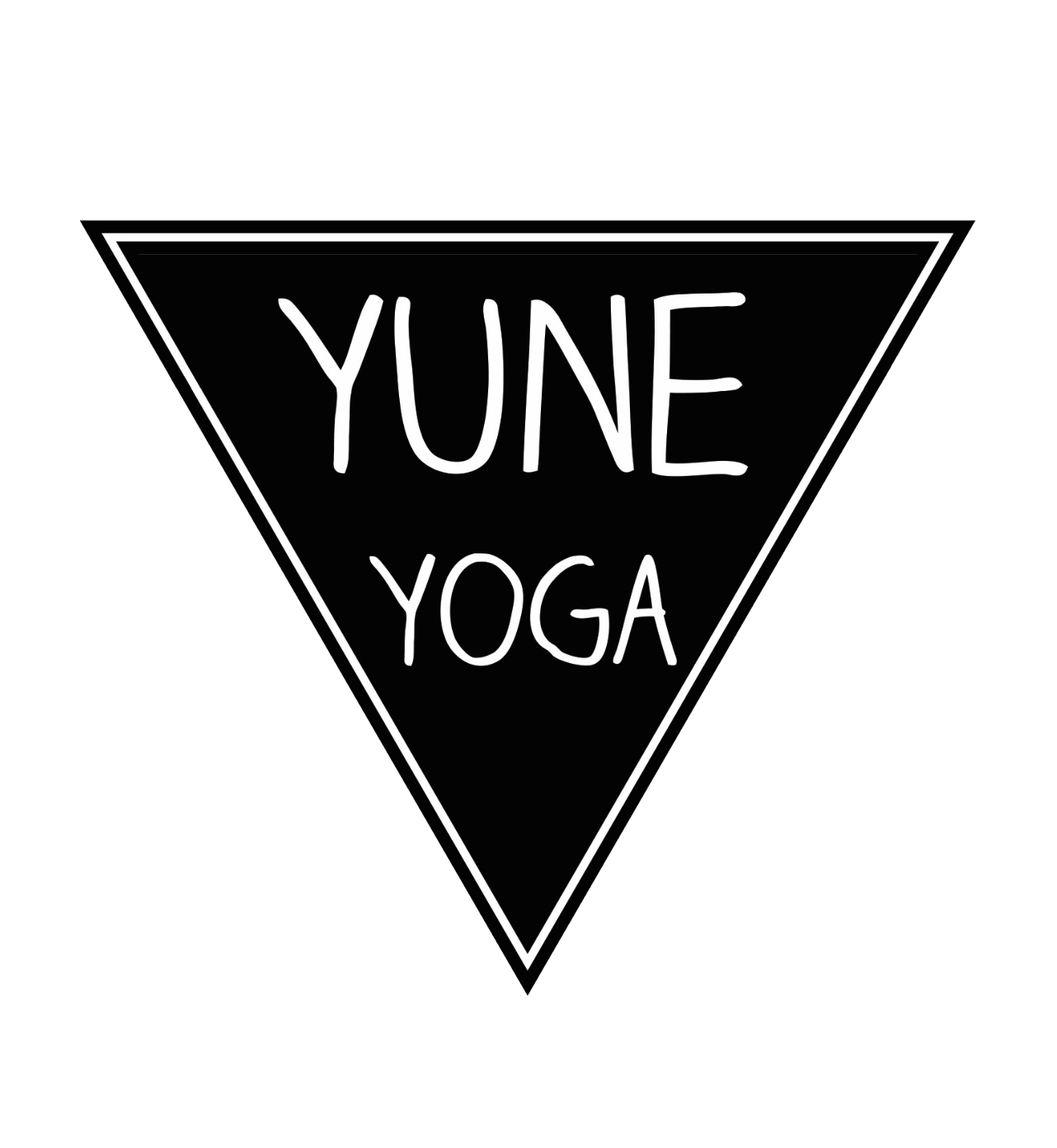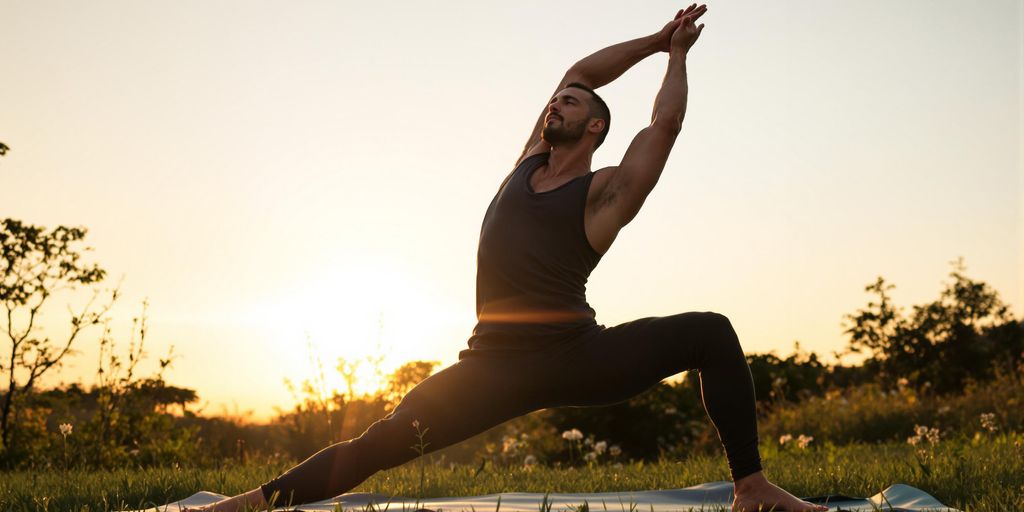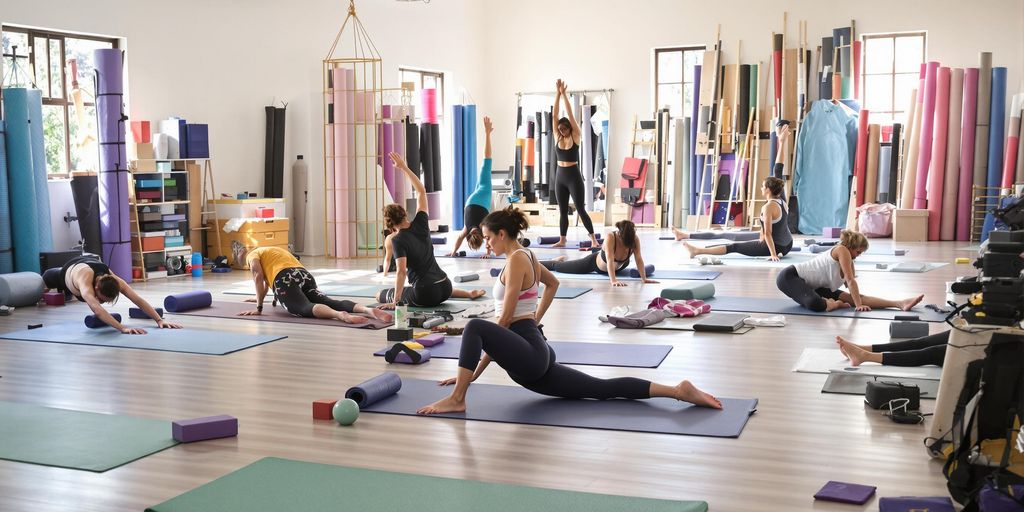
Unlocking Serenity: 10 Essential Beginner Poses Yoga for a Tranquil Practice
Yoga is a great way to find some calm in the middle of life’s chaos. If you’re new to it, don’t worry—there are plenty of simple poses to get you started. This post will walk you through 10 beginner-friendly yoga poses that are easy to try and perfect for creating a peaceful practice. Whether you’re looking to start your day with energy or wind down at night, these poses have got you covered.
Key Takeaways
- Yoga is beginner-friendly and great for relaxation.
- You can practice yoga anywhere, even at your desk.
- Simple poses like Child's Pose and Forward Fold help release tension.
- Breathing exercises like Pranayama calm the mind.
- Consistency in yoga practice leads to better mental clarity and peace.
1. Morning Sun Salutations
Sun Salutations, or Surya Namaskar, are a fantastic way to start your day. This sequence of movements flows smoothly from one pose to the next, syncing each action with your breath. It’s the ultimate wake-up call for both your body and mind.
Benefits of Morning Sun Salutations:
- Gently stretches and warms up your muscles.
- Improves blood circulation, giving you a boost of energy.
- Encourages mindfulness as you focus on your breathing.
How to Perform:
- Begin in Mountain Pose (Tadasana), standing tall with your feet together and hands at your sides.
- Inhale as you raise your arms overhead, reaching up and slightly back.
- Exhale and fold forward into a Forward Fold, letting your hands reach for the ground.
- Step or jump back into Plank Pose, holding for a breath.
- Lower down into Chaturanga (a low push-up), then inhale into Cobra or Upward Dog.
- Exhale into Downward Dog, holding for a few breaths.
- Step or jump forward to return to Forward Fold.
- Inhale as you rise back up, arms overhead, and exhale to return to Mountain Pose.
Pro Tip:
Even if you’re short on time, completing just 3-5 rounds can leave you feeling refreshed and ready to tackle your day.
Let this sequence be your morning ritual, a moment to center yourself before the chaos begins. It’s not about perfection—it’s about showing up for yourself.
For a more comfortable practice, consider using a supportive yoga mat like the Yune Yoga Mat, which combines style and function to enhance your experience.
2. Desk Chair Cat-Cow Stretch

Sitting at a desk all day can leave your back feeling stiff and your shoulders tense. The Desk Chair Cat-Cow Stretch is a simple yet effective way to counteract this. This stretch alternates between arching and rounding your spine, helping to release tension and improve posture. The best part? You can do it right in your chair without disrupting your workflow.
How to Perform the Desk Chair Cat-Cow Stretch:
- Sit on your chair with your feet flat on the ground and your hands resting on your knees.
- As you inhale, arch your back, lift your chest, and tilt your pelvis forward. This is the "Cow" position.
- On the exhale, round your spine, tuck your chin to your chest, and pull your belly button toward your spine. This is the "Cat" position.
- Repeat this cycle for 5-10 breaths, moving slowly and mindfully.
Taking just a few moments to practice this stretch can leave you feeling refreshed and more focused, even on the busiest days. It’s a quick win for your body and mind.
This stretch is especially great for those long workdays when you’re glued to your chair. By incorporating it into your routine, you’ll not only feel better but also promote better spinal health over time. For more on the benefits of this stretch, check out the Cat-Cow Stretch and how it enhances flexibility and overall well-being.
3. Forward Fold
The Forward Fold, or Uttanasana, is a simple yet transformative pose that stretches your hamstrings, calves, and back while calming your mind. This pose is perfect for releasing physical and mental tension.
How to Practice Forward Fold:
- Start in a standing position with your feet hip-width apart.
- Inhale deeply to lengthen your spine.
- As you exhale, hinge at your hips and fold forward, letting your arms and head hang freely.
- Keep a slight bend in your knees if your hamstrings feel tight.
- Hold the position for 5-10 breaths, allowing gravity to deepen your stretch naturally.
Benefits of Forward Fold:
- Relieves tension in the lower back and hamstrings.
- Promotes better blood flow to the brain, enhancing focus and clarity.
- Encourages relaxation and reduces stress levels.
Taking a moment to let go in a Forward Fold can feel like hitting a reset button for your body and mind. The gentle inversion helps you pause, breathe, and reconnect with yourself in the midst of a busy day.
For an even more grounding experience, consider practicing this pose on the Dora Szentmihalyi Jungle Yoga Mat. Its cushioned surface provides the perfect support for your practice, making it easier to focus on your breath and posture.
4. Child’s Pose
Child’s Pose, or Balasana, is one of the most restorative and grounding yoga poses you can try. It’s perfect for beginners and seasoned yogis alike. This pose is all about finding calm and creating space for your breath.
How to Get Into Child’s Pose
- Start by kneeling on your mat with your big toes touching and your knees spread apart. If it feels better, you can keep your knees closer together.
- Sit back onto your heels, stretching your arms forward as you lower your chest toward the ground.
- Rest your forehead gently on the mat. If this feels uncomfortable, use a folded blanket or block under your forehead for support.
- Let your arms stay extended forward, or bring them alongside your body with palms facing up for a more relaxed variation.
Benefits of Child’s Pose
- Stretches the lower back and hips gently.
- Calms the nervous system and encourages mindfulness.
- Relieves tension in the shoulders and neck.
Taking a moment in Child’s Pose can feel like hitting the reset button for your body and mind. It’s a simple way to pause and reconnect with your breath, especially during a hectic day.
If you’re looking for a yoga pose that truly promotes relaxation and mindfulness, Child’s Pose is a great place to start. It’s like a mini retreat for your body, helping you recharge in just a few breaths.
5. Seated Forward Fold
The Seated Forward Fold, or Paschimottanasana, is a cornerstone pose in yoga that offers a deep stretch for your hamstrings, spine, and lower back. It’s a calming posture that encourages both physical and mental relaxation. This pose is perfect for winding down at the end of the day or finding a moment of peace amidst a busy schedule.
How to Practice Seated Forward Fold
- Sit on the floor with your legs extended straight out in front of you. Keep your spine tall and your shoulders relaxed.
- Inhale deeply, lifting your arms overhead to lengthen your torso.
- As you exhale, hinge at your hips and reach forward toward your feet. Avoid rounding your back; instead, focus on maintaining a long spine.
- Rest your hands wherever they naturally fall—on your shins, ankles, or feet. If needed, you can use a strap around your feet to assist.
- Hold the pose for several breaths, allowing your body to relax deeper into the stretch with each exhale.
Benefits of Seated Forward Fold
- Stretches the hamstrings, calves, and lower back.
- Helps calm the mind and reduce stress.
- Improves digestion by gently massaging the abdominal organs.
Taking time for a Seated Forward Fold can feel like hitting the pause button on life's chaos. It's not about how far you can reach but about finding stillness and surrender in the moment.
For even more depth, this pose engages muscles like the piriformis and external rotators, which are key for hip stabilization and tension relief.
6. Legs Up the Wall
Sometimes, all you need is a simple reset, and "Legs Up the Wall" is the perfect pose for that. It’s restorative, calming, and ridiculously easy to do. This pose works wonders for releasing tension and improving circulation, especially after a long day of standing or sitting.
How to Do It:
- Find a clear wall space and sit sideways, with one hip touching the wall.
- Swing your legs up onto the wall as you lower your upper body down to the floor.
- Adjust so your hips are as close to the wall as feels comfortable.
- Rest your arms by your sides, palms facing up, and let your body relax.
- Stay here for 5-10 minutes, focusing on slow, deep breaths.
Benefits of Legs Up the Wall:
- Helps reduce swelling in the legs and feet.
- Encourages better blood flow and eases tired muscles.
- Aids in calming the mind, making it a great pre-bedtime practice.
This pose is like hitting the "pause" button on your day. It’s a reminder that sometimes the simplest actions can bring the biggest relief. Take a moment here, and let the world fade into the background.
For an even more comfortable experience, try using a supportive yoga mat like The Dion Yoga Mat, which offers a wide and stable surface perfect for restorative poses like this.
7. Seated Twist
The Seated Twist is a simple yet effective pose that helps release tension from the spine and improve flexibility. This pose is perfect for anyone who spends long hours sitting or commuting, as it gently counters the effects of a sedentary lifestyle.
Steps to Perform the Seated Twist
- Sit comfortably on the floor with your legs extended straight in front of you. If this feels uncomfortable, you can sit on a folded blanket for support.
- Bend your right knee and place your right foot flat on the floor, just outside your left thigh.
- Place your right hand behind you for support and your left elbow on the outside of your right knee.
- Inhale deeply to lengthen your spine, and as you exhale, gently twist your torso to the right. Look over your right shoulder.
- Hold the pose for 5-10 breaths, deepening the twist slightly with each exhale.
- Slowly return to the center and repeat on the other side.
Benefits of the Seated Twist
- Relieves tension in the back and shoulders.
- Improves spinal mobility and posture.
- Aids in digestion by gently massaging the abdominal organs.
Practicing the Seated Twist regularly can be a quiet reminder to slow down and realign, both physically and mentally. It’s a moment to breathe and reset in the middle of a busy day.
For added stability during this pose, consider using a non-slip yoga mat like the Pisces Trekk Travel Mat. Its design ensures you stay grounded while focusing on your twist.
8. Rejuvenating Child’s Pose
Child’s Pose, or Balasana, is like hitting the pause button for your body and mind. It’s a simple yet deeply restorative position that anyone can do, whether you're new to yoga or a seasoned practitioner. This pose is perfect for unwinding after a long day or finding a moment of calm amidst chaos.
Here’s how to get into it:
- Start on your hands and knees on the mat.
- Bring your big toes together and sit back on your heels.
- Stretch your arms forward, or let them rest alongside your body.
- Lower your forehead to the mat and take slow, deep breaths.
Benefits of Child’s Pose
- Relieves tension in the lower back and hips.
- Gently stretches the spine, thighs, and ankles.
- Calms the mind and reduces stress.
- Encourages a sense of grounding and relaxation.
Taking a few minutes in Child’s Pose can feel like a mini-vacation for your nervous system. It’s a chance to let go of the day’s weight and reconnect with your breath.
For those looking to enhance their practice, Child’s Pose can also be a great way to enhance spinal flexibility while decompressing the lower back. It’s a simple move with a big impact on your overall well-being.
9. Mindful Meditation
Mindful meditation is like hitting the pause button on life’s chaos. It’s a chance to sit still, breathe, and just be. This simple practice can help you feel more grounded, calm, and aware. Let’s break it down into easy steps so you can start today:
- Find a quiet spot. Sit comfortably, whether that’s on a chair, a cushion, or even the floor. Keep your back straight but not stiff.
- Close your eyes or keep them softly focused on something in front of you. Let your hands rest gently on your knees or in your lap.
- Focus on your breath. Notice the air as it moves in and out. Feel the rise and fall of your chest or the sensation at the tip of your nose.
- Let thoughts come and go. Your mind will wander—it’s normal. When it does, gently guide your attention back to your breath without judgment.
Even just five minutes of mindful meditation can leave you feeling refreshed and ready to take on the day. It’s not about perfection; it’s about showing up for yourself.
For those integrating yoga and meditation, consider finishing your session with Savasana. This classic pose allows your body and mind to absorb the benefits of both practices, creating a seamless transition into a state of relaxation and peace.
10. Breath Focused Pranayama

Breath-focused pranayama is a simple yet powerful way to center yourself and calm an overactive mind. By tuning into your breath, you can create a sense of balance and ease, even on the most chaotic days. Here’s how to get started:
Steps to Practice Breath-Focused Pranayama
- Find a comfortable seat: Sit in a chair or on the floor, keeping your back straight but relaxed. This helps your lungs expand fully.
- Close your eyes: Gently close your eyes to reduce distractions and focus inward.
- Start with deep breaths: Inhale deeply through your nose for a count of four, letting your belly rise. Exhale slowly for a count of six, feeling your belly fall. Repeat this for a few cycles.
- Try a technique: Experiment with methods like Alternate Nostril Breathing (Nadi Shodhana) or the 4-7-8 technique for deeper relaxation.
- Stay present: If your mind starts to wander, gently bring your focus back to the rhythm of your breath.
Even just five minutes of conscious breathing can leave you feeling refreshed and more in control. Think of it as a reset button for your day.
Benefits of Breath-Focused Pranayama
- Reduces stress and anxiety.
- Improves focus and mental clarity.
- Enhances overall emotional well-being.
Commit to a short daily practice, and you’ll likely notice a shift in how you handle life’s ups and downs.
Wrapping It Up
Starting yoga might feel a little overwhelming at first, but it’s really about showing up for yourself, one pose at a time. These beginner-friendly poses are a great way to ease into the practice and discover what works for you. Whether you’re looking to relax, stretch, or just take a breather from the chaos of daily life, yoga offers a little something for everyone. So, roll out your mat, take a deep breath, and enjoy the journey. It’s not about being perfect—it’s about finding your own rhythm and making space for a bit of calm in your day. Keep practicing, and you’ll be amazed at how much it can shift your mindset and bring a sense of peace to your life.
Frequently Asked Questions
What is the best time to practice yoga for beginners?
Morning is often the best time to practice yoga as it helps awaken your body and mind. However, any time that fits your schedule works, as consistency is key.
Do I need special equipment to start yoga?
Not at all! A yoga mat is helpful for comfort and stability, but you can start with just a soft surface like a carpet or towel.
How long should a beginner practice yoga daily?
Start with 10 to 15 minutes a day. As you become more comfortable, you can gradually increase the duration based on your needs and schedule.
Can yoga help reduce stress and anxiety?
Yes, yoga combines physical movement, breathing exercises, and mindfulness, all of which are effective in reducing stress and promoting relaxation.
Is yoga suitable for people who are not flexible?
Absolutely! Yoga is for everyone, regardless of flexibility. It helps improve flexibility over time, so just start at your own pace.
What should I wear for a yoga session?
Wear comfortable clothing that allows you to move freely, such as stretchy pants and a fitted top. There's no need for fancy gear—just something you feel good in.


